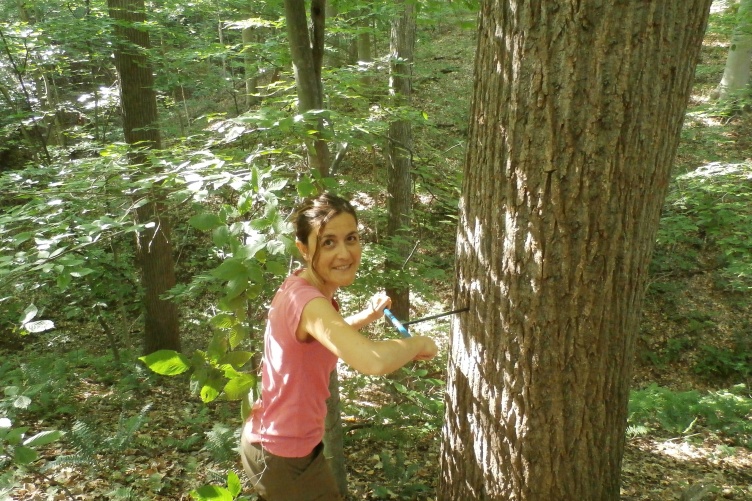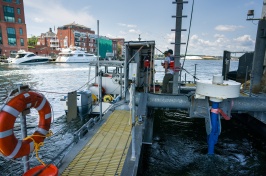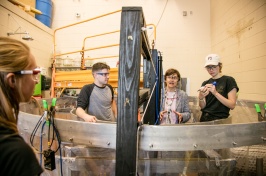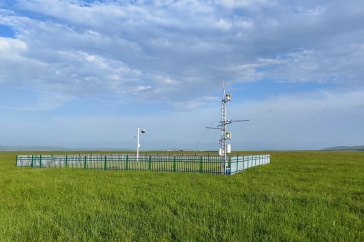
Rossella Guerreri takes a wood core sample from a tree to determine impacts of increasing levels of atmospheric carbon dioxide on forests. Photo by Katie Jennings.
As carbon dioxide (CO2 ) increases in the atmosphere, trees across the U.S. are responding by growing more and conserving water when needed, according to new research from the University of New Hampshire. By using a novel approach to investigate these changes, scientists are learning more about how forests are helping to mitigate climate change.
Trees take in water and carbon dioxide to grow, and they lose water vapor through pores on the surface of their leaves as a result; they can adjust the amount they take up or emit based on changing environmental conditions. Scientists previously suspected increasing atmospheric carbon dioxide levels would result in less tree water loss, but this new research provides a more detailed analysis that tells a more complicated story.

ISOTOPE ANALYSES OF TREE RINGS HELPED SCIENTISTS FIGURE OUT HOW TREES ARE RESPONDING TO RISING ATMOSPHERIC CARBON DIOXIDE.
“Plants are smart,” says Scott Ollinger, director of the UNH Earth Systems Research Center and a co-author on the study that was recently published in the Proceedings of the National Academy of Sciences. “If you give them more CO2, and they don’t need to conserve water, they’ll photosynthesize faster and continue to lose water at the same rate. But at sites where water is scarce, they shift toward conserving water at the expense of faster growth. That’s the main takeaway from our research, and it runs counter to what’s been in the literature so far,” he explains.
The study focused on the water-use efficiency of forests, which is the tradeoff between carbon dioxide uptake during photosynthesis and water loss during transpiration. Put another way, water-use efficiency indicates how much a plant grows relative to how much water it uses.
“It’s like a car’s miles per gallon, but instead, it’s tons of carbon per gallon of water,” Ollinger explains.
Water-use efficiency has been increasing in trees across the globe, but it was unclear how and why that’s been happening. The research team examined eight sites representing a range of water availability across the country. Researchers extracted wood cores from the stems of the two most dominant tree species on each site, and the most recent 30 years were identified, with each ring analyzed for carbon and oxygen isotopes — a technique that ultimately helped scientists discern what is happening with the trees.
“This isotope approach in tree rings is the only method that allows us to figure out how trees have responded to the rise in atmospheric CO2 and climate variability over the past decades or even the past century,” says Rossella Guerrieri, first author on the study, who conducted the research while she was a postdoctoral researcher at UNH. She’s currently a postdoctoral researcher at the Centre for Ecological Research and Forestry Applications in Barcelona, Spain. The bottom line, Guerrieri says, is “forests play a crucial role in removing part of the CO2 we emit into the atmosphere, but this uptake comes at a cost to trees” that requires them to adapt accordingly with their water-use efficiency.
The researchers also found that different tree species have different capabilities and make different carbon/water tradeoffs. Because climate variability is increasing, the implication is that maintaining a diversity of tree species will help forests continue providing the climate mitigation benefits we rely on.
Meanwhile, Ollinger says the results from this research will help scientists who model climate change do a better job at incorporating plants into the equation. “Forests are part of that climate system, and a pretty large chunk of the water vapor in the atmosphere is regulated by plants, so it’s a feedback loop that can influence everything else for years to come,” Ollinger says.
Funding for this research was provided by NSF, NASA and the USDA through the N.H. Agricultural Experiment Station. The Institute for the Study of Earth, Oceans, and Space (EOS) is UNH’s largest research enterprise, comprising six centers with a focus on interdisciplinary, high-impact research on Earth and climate systems, space science, the marine environment, seafloor mapping and environmental acoustics. With more than $43 million in external funding secured annually, EOS fosters an intellectual and scientific environment that advances visionary scholarship and leadership in world-class research and graduate education.
-
Written By:
Rebecca Irelan | Institute for the Study of Earth, Oceans, and Space | rebecca.irelan@unh.edu | 603-862-0990






















































